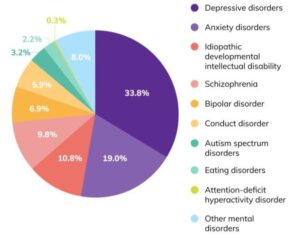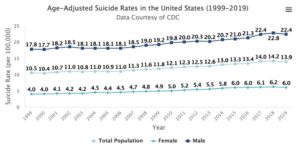Adrian Zenklusen (Theme 5)
In the past mental health was something which people did not spoke about. In many cultures, mental illness was seen as some form of religious punishment or demonic possession. (PBS, 2012) With this came some obscure types of treatment such as Isolation, bloodletting using leeches or Insulin Coma Therapy in which in the latter roughly 10 percent of the patients died during the treatment. (CSP, kein Datum) Fortunately, science today has better solutions than it did 100 years ago, and there is more talk about mental health, but unfortunately there is still a certain stigma attached to it. Although we are better off than in the past and our GDP is growing every year, the incidence of mental illness is increasing rapidly. In America in 2020, one in five experienced mental illness. Suicide is among the 15 leading causes of death and experts predict this will increase. (Ritchie & Roser, 2019) A topic that is naturally also represented in the SDGs. SDG 3 deals with good health & well-being and more specifically SDG 3.4 by 2030, reduce by one third premature mortality from non-communicable diseases through prevention and treatment and promote mental health and well-being. (United Nations, kein Datum)
Why mental illness is on the rise
Mental illness is on the rise, especially among adolescents and young adults. The American Psychological Association published a study back in 2019 where they stated the rates of mood disorders and suicide-related events have significantly increased in the last decade within these age groups, especially among females and the wealthy. (Twenge, Cooper, Joiner, Duffy, & Binau, 2019) Mental health is a broad term. The following figure gives an overview of the different forms of mental health.

But why are mental illnesses on the rise? There are many possible reasons and each person has their own personal story. If there were a universal reason, one could try to fix it, but unfortunately it is often an interplay of different factors. A few of the most common reasons are listed below:
– Increased parental pressures
– Increased adoption of electronic media (Electronic Screen Syndrome)
– Increased performance pressures (education, career, financial, etc.)
– Increased terrorist events and threats
– Increase in divisive news
– Dramatic increase in violent TV programs, movies, and video games
– Dramatic increase in graphic children’s media
– Increase in sexually explicit material (TV programs, movies, video games, easy access online, etc.)
– Social media pressure
– Reduced face-to-face interactions and social supports
– The breakdown of the family unit
– Sexual orientation confusion
– Gender confusion
And, unfortunately, many more. Our lives may have become easier in terms of survival and work, but social norms have changed. This has serious consequences for our health, both psychologically and emotionally. Research shows that this change is affecting everyone, especially today’s children, which does not bode well for our future. (Folk, 2021) Researcher had identified another alarming trend. There is a shortage of mental health resources to help those who are suffering with mental illness. So, there is a rising trend in mental illness and suicide but also fewer resources to help address these rising trends.
Mental health in SDGs
In 2015, mental health was added to the list of SDGs. This proved once again that mental health is a serious issue. By including it in the SDGs, the UN recognized the disease burden of mental illness and thus also defined it as a priority for global development over the next 15 years. The main reason for the inclusion in the SDGs, in addition to numerous individuals and organizations, was the global initiative FundaMentalSDG, which is a global initiative aiming to strengthen mental health in United Nations Sustainable Development Goals. Mental health is highly interlinked. To be physically healthy, it virtually requires being mentally healthy as well. Furthermore, mental health is closely linked to other development factors such as poverty, work and economic growth, or peace and justice.
When it comes to efforts to achieve social inclusion and justice, universal health coverage, access to justice and human rights, and sustainable economic development, mental health plays an important role. As one can broadly guess, mental health is therefore linked to many other SDGs, such as poverty (SDG 1), as well as economic growth (SDG 8) and safe and resilient cities and settlements (SDG 11). All these goals depend to a greater or lesser extent on an overall mentally healthy society. Thus, mental health can be said to matter across the spectrum of development. (Votruba & Thornicroft, 2016)
In the 2014 Synthesis Report, the United Nations Secretary-General wrote that rigorous and robust measurement will determine the success of the global goals. Any desired improvements in global development must be measured and tracked using reliable systematic data and indicators that include some level of disaggregation to address inequalities and disparities. Two indicators have been proposed by WHO to strengthen mental health in the SDGs, which are fully consistent with WHO’s Global Mental Health Action Plan, one is suicide rate and the other is coverage rate (proportion of people treated) of people with serious mental illness. Right now, the UN is only using the suicide mortality rate to measure the SDG 3.4. (WHO, 2018) So, let’s have a look at the suicide mortality rate

Conclusion
As you can see, the suicide rate is increasing. More and more people are suffering from mental illness. Experts predict that mental illness will be one of the most prevalent diseases in the future. Unfortunately, there is no easy solution to this. It takes a comprehensive rethinking of many factors that currently contribute to it and then adopting healthy changes. But the way society has developed and where it is currently heading, it is unlikely that we will see a positive change in the near future, rather the opposite, as experts predict, things are expected to get much worse. So, the best we can do is to take advantage of available mental health resources and then work to get families well, one person at a time.
References
CSP. (kein Datum). Von A History of Mental Illness Treatment: Obsolete Practices: https://online.csp.edu/resources/article/history-of-mental-illness-treatment/ abgerufen
Folk, J. (27. 03 2021). anxyeitycentre. Von Why Is Mental Illness On The Rise?: https://www.anxietycentre.com/faq/why-is-mental-illness-on-the-rise/ abgerufen
PBS. (27. 06 2012). Von Treatments for Mental Illness: https://www.pbs.org/wgbh/americanexperience/features/nash-treatments- mental-illness/ abgerufen
Ritchie, H., & Roser, M. (12 2019). Our World in Data. Von Causes of death: https://ourworldindata.org/causes-of-death abgerufen
Twenge, J. M., Cooper, A. B., Joiner, T. E., Duffy, M. E., & Binau, S. G. (2019). American Psychological Association. Von Age, Period, and Cohort Trends in Mood Disorder Indicators and Suicide- Related Outcomes in a Nationally Representative Dataset, 2005–2017: https://www.apa.org/pubs/journals/releases/abn-abn0000410.pdf abgerufen
United Nations. (kein Datum). Von Ensure healthy lives and promote well-being for all at all ages: https://sdgs.un.org/goals/goal3 abgerufen
Votruba, N., & Thornicroft, G. (09. 09 2016). Cambridge. Von Sustainable development goals and mental health: learnings from the contribution of the FundaMentalSDG global initiative: https://www.cambridge.org/core/journals/global-mental- health/article/sustainable-development-goals-and-mental-health-learnings-from- the-contribution-of-the-fundamentalsdg-global- initiative/11C74357A926DCB0A7CA7999901CDF1E abgerufen
WHO. (2018). Von Fact sheet on Sustainable Development Goals (SDGs): health targets : https://apps.who.int/iris/bitstream/handle/10665/340847/WHO-EURO-2018- 2364-42119-58012-eng.pdf?sequence=1&isAllowed=y abgerufen
(Figures need caption and source information, BW)